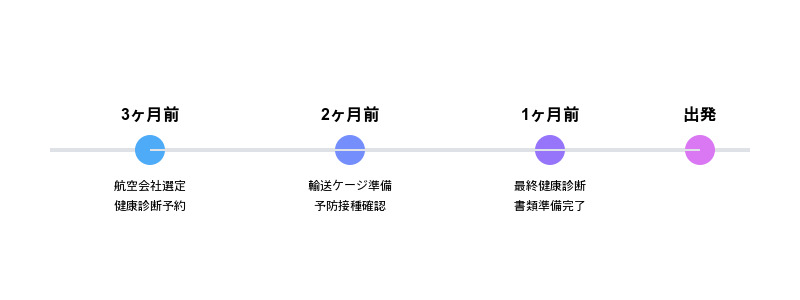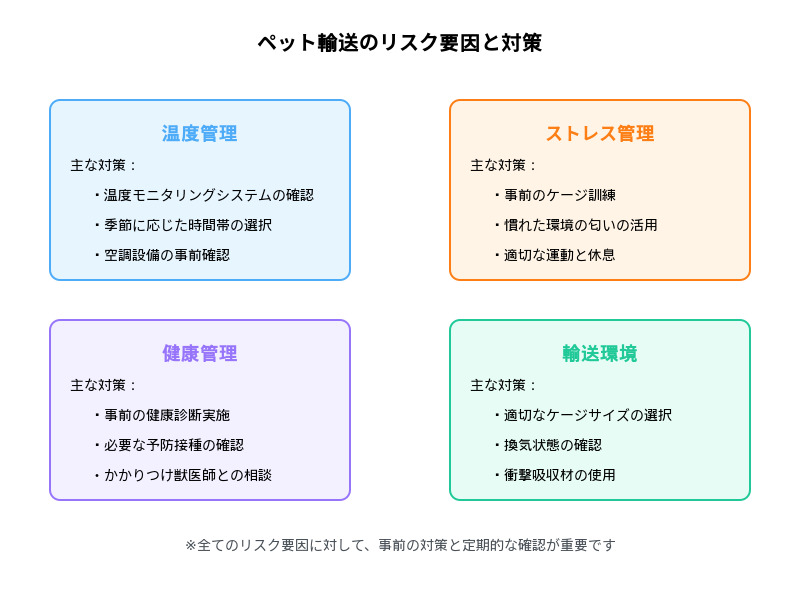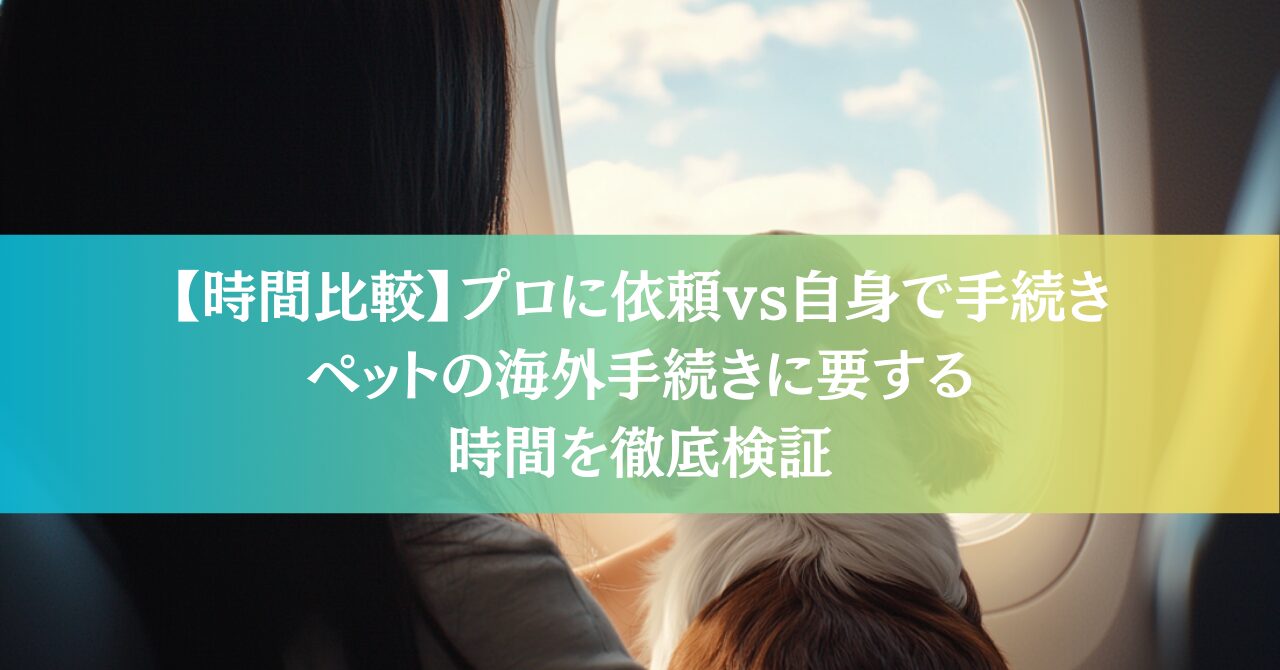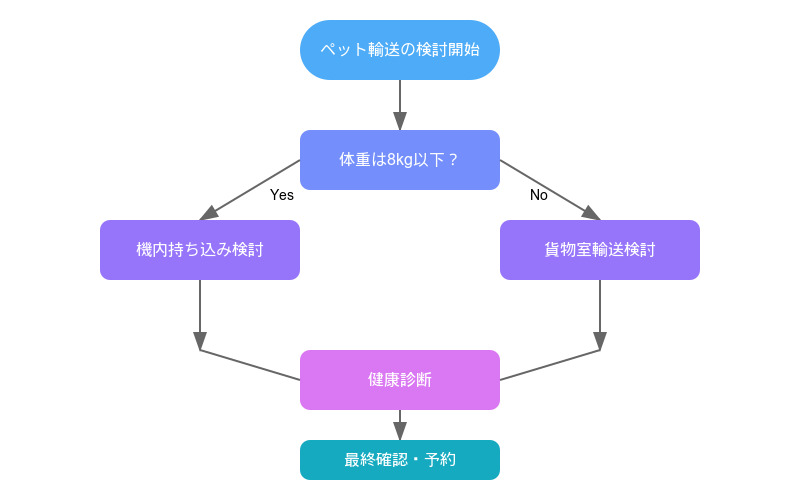This is a complete guide to safely transporting your precious pets. From how to choose an airline to specific procedures, this guide provides an expert's perspective so that even first-timers can prepare with confidence. We provide the latest information, taking into account recent changes in air transportation.
✓ Differences in response by different airlines and selection criteria
✓ Preparation Checklist for Safe Transport
✓ Precautions and measures to prevent problems
Basic Knowledge of Pet Transportation
Difference between carry-on and cargo compartment transportation
| Comparison items | (of luggage, etc.) able to be taken into the cabin of the aircraft | Cargo hold transport |
|---|---|---|
| Eligible Pets | Small dogs and cats (8 kg or less) | Medium and large dogs, small dogs and cats over 8 kg |
| Advantages |
|
|
| constraint |
|
|
| Fee Guideline | 10,000 to 30,000 yen | 30,000-100,000 yen |
Important points to consider when choosing a transportation method
Selection Criteria for Pet Transport Methods
| evaluation criteria | detail item | considerations |
|---|---|---|
| Pet Characteristics | Age and health status |
|
| Personality and Behavioral Characteristics |
|
|
| Physique and breed |
|
|
| Flight Characteristics | Flight Time |
|
| seasonal factor |
|
2. how to choose an airline
Comparison of pet transportation services of major airlines
We evaluated each airline's service quality from three perspectives: temperature control, safety, and support system:
| airline company | Services available | Distinctive Response | Restrictions |
|---|---|---|---|
| ANA (All Nippon Airways) |
|
|
|
| JAL (Japan Airlines) |
|
|
|
| Delta Air Lines |
|
|
|
| KLM Royal Dutch Airlines |
|
|
|
| Air Canada |
|
|
|
| Lufthansa Airlines |
|
|
|
| United Airlines |
|
|
|
Important Points for Airline Selection
Basic checks when selecting an airline
| checklist | Confirmation details | priority (e.g. traffic) |
|---|---|---|
| Transportation Performance and Reputation | Past accident response history | most important
|
| Check user reviews | important
|
|
| Evaluations from Veterinarians | most important
|
|
| Degree of safety measures taken | Temperature Control System | most important
|
| Monitoring System | important
|
|
| Emergency Response Protocol | most important
|
3. how to choose the transportation method
Selecting the appropriate transportation method based on the pet's condition
Health Assessment
| checklist | Carry-on recommended | Cargo compartment transport recommended | Consideration to forgo transportation |
|---|---|---|---|
| age |
|
|
|
| (the condition of) one's health |
|
|
|
| Personality and Behavior |
|
|
|
Seasonal and climatic considerations
Precautions and measures in seasonal transportation
| season | important point | Specific measures |
|---|---|---|
| Summer Transportation (June-September) |
Stress from high temperatures |
|
| Risk of dehydration |
|
|
| Restrictions on short-horse breeds |
|
|
| Winter Transportation (Dec-Feb) |
Stress due to low temperatures |
|
| Risk of freezing |
|
|
| Anti-Dryness |
|
Transportation restrictions due to weather conditions
| weather conditions | Restrictions | countermeasure |
|---|---|---|
| Temperatures above 35 degrees Celsius | Possible discontinuation of transportation | Consider changing the schedule |
| Temperature below 5 degrees Celsius | Some restrictions apply. | Reinforcement of heat insulation measures |
| Strong winds and heavy rain | Affects on-boarding decisions | Secure alternative flights |
4. complete guide to preparation and procedures
Preparation Schedule
Follow the timeline below to prepare for safe transportation:

Preparation details by time
| time | Preparation items | Specific Work |
|---|---|---|
| 3 months ago | Airline Selection and Reservations | Compare the conditions of several airlines |
| Confirmation of reservation slots and tentative reservations | ||
| Check Rate Plans | ||
| Health Screening Appointment | Appointment at your family veterinarian | |
| Confirmation of required vaccinations | ||
| Confirmation of medical history | ||
| 2 months ago | Confirmation and preparation of required documents | Passport Preparation (International Flights) |
| Obtaining immunization certificates | ||
| Confirmation of health certificate requirements | ||
| Preparation of transportation supplies | Purchase a cage that meets IATA standards | |
| Start of cage training | ||
| Listing of equipment needed | ||
| 1 month ago | Strengthening Health Care | Regular health checks |
| Stress Reduction Training | ||
| Adjustment of dietary management | ||
| Final confirmation | Final confirmation with airline | |
| Reconfirmation of documents | ||
| Confirm contact information in case of emergency |
Checklist of Required Documents
| classification | necessary documents | precautions | Acquisition period |
|---|---|---|---|
| Basic Required Documents | health certificate |
|
Obtained within 10 days of departure |
| rabies vaccination certificate |
|
Expiration date within 1 year | |
| Microchip registration certificate |
|
Pre-acquisition | |
| Additional documents for international flights | Export Quarantine Certificate |
|
Obtained at the animal quarantine station |
| import license |
|
Depends on the destination country's regulations |
All documents should be original and photocopies are recommended.
For international flights, a certificate in English may be required.
List of required preparations
| category | things to be prepared | remarks | priority (e.g. traffic) |
|---|---|---|---|
| transportation goods | IATA compliant cage | Size and standard confirmation required | indispensable |
| Water supply unit (freeze-prevention type) | Confirmation of secure fixation | indispensable | |
| Water absorbent mat | Prepare sufficient number of sheets | indispensable | |
| Name tags and signs | Waterproof | indispensable | |
| care products | Favorite Toys | Small and safe | recommendation |
| Familiar blanket | For familiar scent | recommendation | |
| household medicine | Preparation after consultation with a veterinarian | depending on circumstances | |
| Relaxation goods | Veterinarian recommended | recommendation | |
| emergency supplies | First Aid Kit | Basic first aid supplies | indispensable |
| Spare absorbent pad | Prepare more sheets than expected | indispensable | |
| Wet wipes for pets | Unscented type is recommended | recommendation | |
| Emergency Contact List | Veterinary and airline contacts | indispensable |
Recommended: Desirable items to have
Depends on the situation: Prepare according to the pet's condition
Transport cage preparation and standards
IATA standard requirements
| (data) item | Requirement Details | Check Point |
|---|---|---|
| Size |
|
|
| structure |
|
|
| equipment |
|
|
Cage training steps for pet transportation
| stage | Period | Training Content | Points to note |
|---|---|---|---|
| introductory period (e.g. to a new product or service) | Week 1 | Installed with cage open |
|
| Induction with snacks |
|
||
| Permission for free entry and exit |
|
||
| Familiarization period | 2nd week | Feeding in a cage |
|
| Short door closing practice |
|
||
| Praise and reward |
|
||
| full-scale training | After 3 weeks | Long-stay practice |
|
| Movement practice |
|
||
| Familiarity with environmental sounds |
|
Please adjust the progress according to your pet's personality and age.
Forced training may be counterproductive.
The following article explains more about pet transport gauges.
5. precautions and risk measures
Major Risk Factors and Countermeasures
Special attention should be paid to the following factors for the safe transportation of pets

Temperature control and stress management
| control item | Target Period/Scene | Specific measures | Implementation period |
|---|---|---|---|
| Temperature control (Summer) |
When selecting a flight | Choose early morning or evening flights | at the time of reservation |
| standby time (e.g. cellular phones) | Temperature control during airport standby time | very day | |
| things to be prepared | Prepare spare refrigerant | day before departure | |
| physical condition control | Hydration management | 24-hour (e.g. observation, operation (of a machine), care (of patient)) | |
| Temperature control (Winter) |
Thermal insulation | Preparation and use of cold-weather equipment | Before Departure |
| Route Confirmation | Confirmation of flights via cold weather | at the time of reservation | |
| things to be prepared | Preparation of thermal insulation | day before departure | |
| Equipment measures | Measures to prevent freezing of water supply units, etc. | very day | |
| Stress Management (Advance preparation) |
training | Cage familiarization training (2 weeks prior) | 2 weeks prior to |
| environmental improvement | Prepare familiar toys and blankets | 1 week before | |
| medication management | Use of supplements as needed | Veterinary consultation required | |
| Adaptation to sound | Habituation training to environmental sounds | 2 weeks prior to | |
| Stress Management (Same-day service) |
Exercise Management | Moderate exercise promotes fatigue. | Before Departure |
| Moisture Management | Water supply at the right time | 24-hour (e.g. observation, operation (of a machine), care (of patient)) | |
| way of dealing with | Calm demeanor | 24-hour (e.g. observation, operation (of a machine), care (of patient)) | |
| Environmental Management | Elimination of unnecessary stressors | 24-hour (e.g. observation, operation (of a machine), care (of patient)) |
Individual differences in pets must be taken into account.
If any abnormality is observed, consult a veterinarian immediately.
Emergency Response Plan
Possible problems and countermeasures
| situation | Initial response | secondary support | precautionary measures |
|---|---|---|---|
| Flight Delays |
|
|
|
| Signs of poor health |
|
|
|
6. frequently asked questions (FAQ)
Q1: Can you transport short-breed dogs (pugs, bulldogs, etc.)?
Special care must be taken in the transportation of shorthorse breeds:
Restrictions by Airline
-
- Transportation restrictions during the summer months
- Special health certificate request
- Refusal to transport by some airlines
Necessary measures
-
- Special health examinations by a veterinarian
- Recommended for transport in periods of low temperatures
- Ensure adequate acclimatization period
Q2: What should I be aware of if I have to make a connection on an international flight?
transit time
-
- At least 3 hours recommended
- Customs formalities time considerations
- Reserve time
Required Confirmation
-
- Pet facilities at transfer airports
- Quarantine regulations in each country
- Cooperation system among airlines
Q3: Can I check the condition of my pet during transportation?
The method of confirmation differs depending on the method of transportation:
For carry-on baggage
-
- Can be visually checked at all times
- Immediate response possible depending on the condition
For cargo compartment transportation
-
- Monitoring system available on some airlines.
- Periodic checks by ground staff
- Emergency contact system available in case of abnormalities
Q4. what are the estimated transportation costs?
| Transport Method | domestic airline (company) | international air route |
|---|---|---|
| (of luggage, etc.) able to be taken into the cabin of the aircraft | 10,000 to 30,000 yen | 30,000 - 80,000 yen |
| Cargo hold transport | 30,000-50,000 yen | 100,000 - 300,000 yen |
*Varies depending on airline, distance, and pet size
Q5. Can I get a refund if I cancel the transportation?
Policies vary by airline:
- Cancellation possible
- Apply at least 72 hours prior to departure
- Submission of veterinarian's certificate
- Cancellation of flights due to bad weather
- Not eligible for refund
- Last minute cancellations
- Incomplete required documents
- Denial of boarding due to pet's condition
Other frequently asked questions are detailed in the following pages.
Expert Advice
The most important aspect of transporting pets is to provide adequate preparation time. We recommend starting preparations at least 2-3 months in advance, especially for international flights. It is also important to take into account your pet's personality and health to select the most appropriate mode of transport."
Summary: For Safe Pet Transportation
The best choice: It is important to choose the airline and method of transport that best suits the characteristics of your pet.
Complete documentation: Make sure that all required documents are prepared well in advance and that there are no omissions.
Health Care:Health checks prior to the event and physical condition up to the day of the event are essential.

Detailed description of the actual time involved in the international shipping process for pets. The typical 90-125 hours of work can be reduced to just 8-11 hours with the use of experts. A thorough guide to the entire process and the nine time-saving benefits. Supports safe and efficient international travel for pets.
Safe and secure overseas travel with pets.

There are many things to prepare for, such as regulations, required documents, and transportation procedures in each country, which can be very anxious.
PetAir JPN will be there for such anxieties of pet owners and provide full support from travel planning to arrival.
Support in preparing necessary procedures and documents
■ Safe and comfortable transportation options
Reliable support until arrival
Reliable Support System✓ Courteous and experienced staff
✓ Understand and respond to the latest regulatory information from each country
✓ Thorough safety management during transportation
\ First of all, free consultation on line! / /

Consultation is completely free of charge.
Free online consultation is also available.
Weekends and holidays are also available.
Please share your experiences and opinions!

Do you have any experiences or questions about traveling abroad with your pet?
If you have actually experienced this, please share with us the points you took care of in your preparation and any problems you had while traveling. We also welcome questions from those who are thinking of traveling to Japan in the future.
Please feel free to comment on any concerns you may have, such as
Your comments will be of great help to others who are struggling with the same issues. Please share your thoughts and questions in the comments section below!
![Support for pets traveling and moving overseas|PetAir JPN [Official] for international transportation and quarantine procedures for dogs and cats Support for pets traveling and moving overseas|PetAir JPN [Official] for international transportation and quarantine procedures for dogs and cats](https://petair.jp/wp-content/uploads/2024/08/main_logo.png?1763387636)




Comment